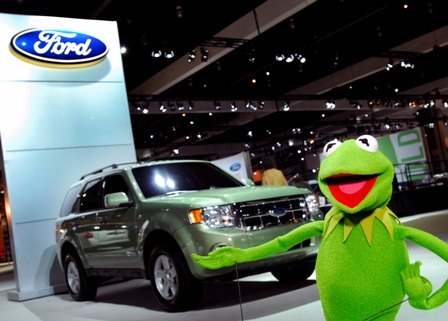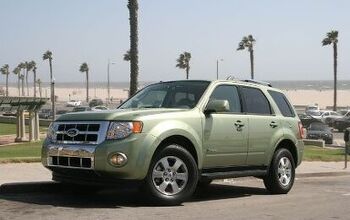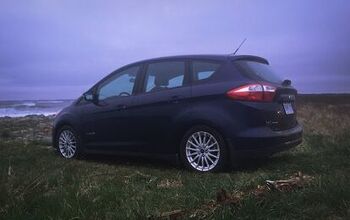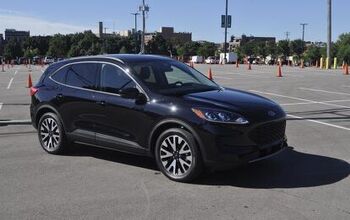2008 Ford Escape Hybrid Review
Ford’s marketers often appear to live in a sort of surrealist parallel universe. How else to explain their enlistment of Kermit, the self-effacing, hand-operated amphibian, to pitch the Ford Escape Hybrid? This SUV has the makings of a game-changing, ass-kicking product. It’s a genuine full hybrid, with components licensed from Toyota. It’s sized, styled and priced to the mainstream’s liking. Yet, saleswise, the hybrid Escape is croaking. Methinks Ford’s spokesfrog hasn’t given the Escape Hybrid the marketing momentum it deserves.
For 2008, Ford’s stylists breathed upon the entire Escape line to stop it disappearing into the crowd. But oy, what a crowd. The compact-‘ute party has been crashed by twelve newcomers since the Escape’s 2001 debut (one suspects free beer). The Escape’s new chromey, square-jawed mug is handsome enough— a little less Kenmore, a little more Clark Kent— but the mechanicals underneath remain largely unchanged.
That’s less a problem for the Hybrid than its gas-only siblings. While the rectilinear sheetmetal marks it as a veteran in this class, the Hybrid’s gas-electric powertrain is as bleeding-edge as anything you’ll find under a Japanese-badged hood. The Hybrid Escape is powered by a 133 hp 2.3-liter four cylinder gas burner, paired with a 70 kw electric motor. The Escape’s prehistoric four-speed auto is replaced by a planetary-type CVT. Under the cargo mat, you’ll find 330 volts’ worth of NiMH batteries.
Drop the spec sheet and plop into the Hybrid’s cabin, and the picture dims a little. The ‘08’s interior also gets a gentle makeover. Ford’s replaced dark, oily-grained stuff polymers with sandy, pebble-grained plastics du jour. A new dash upholds Ford’s blocky, neo-Lego motif. But the appointments remain stark. Touch points are hard. The gauge cluster glares with obnoxious reflections, and the center stack’s tightly-clustered, lookalike buttons are only slightly less busy than a TI-83 graphing calculator’s.
Look up from the IP (needn’t twist your arm there) to spot the upside of the Escape’s advancing years. That’s right, you can actually see out! Sightlines are wide and bright from the Hybrid’s upright, elevated helmspot. Roof posts are no girthier than a pine sapling. And despite the sprawl-out space within, the Escape Hybrid feels tidy and manageable in close quarters, its bluff-cornered hood simplifying distance-to-crunch judgments.
Distance-to-empty is, of course, the more relevant figure. So fire it up and check the trip computer. “Average MPG” should ring in around 30 mpg, given the 34/31 EPA estimates of my $29,865 front-drive tester. The AWD model surrenders a couple of mpg, at 29/27, in exchange for whatever peace of mind the front-biased, on-demand system affords. It also commands a $2500 premium over its FWD stablemate.
Who needs it? At its core, the Hybrid— like other Escapes— is a spacious grocery-getter that places you a foot or two above the madding crowd. And so, we drive.
The gasser four delivers moderate pep, humming benignly under a light throttle foot; heavier inputs send the CVT into the drone zone. The Escape’s chassis tiptoes daintily from block to block, driving lighter than its 3,638 lbs suggest. And the ride, while lumpier than a car’s and noisy over textured surfaces, is solid and rattle-free.
The rest of the Escape range has been prescribed rear drum brakes and electric power steering for 2008, leaving little conceivable reason to buy one. But the Hybrid retains its rear discs, and its steering has always been the fun-free electric variety. As such, it’s no surprise that the four-spoke helm feels vacant and numb in the hands. Fortunately, the rack’s accuracy is unimpeachable, with strong self-centering (insert SUV joke here) and a pleasing hollow heft off-center.
More surprising: the transparency of the Escape’s hybrid system. Far from a stilted freshman effort, the Escape’s drivetrain phases in and out of electric mode quickly and seamlessly. Moreover, its gas engine’s startup/shutdown shudders are subtler than a Prius’. Its regenerative brakes boast a natural pedal feel, too— the action’s a bit stiff, but it’s not at all nebulous or grabby.
So, what’s not to like about the Escape Hybrid? Two things. First, you don’t get an animated power-flow display, a la Toyota, unless you stump for the $2,695 navigation system (a quaint “charge/assist” gauge is standard issue). And second, this Ford is only a pleasure to drive in appliance mode. Pushed hard, the engine brays, the suspension sways, and the hard-compound tires shriek and forget to grip.
Big deal. The Escape Hybrid is for people who’d rather save gas than haul ass. As such, it’s perfectly suited to drivers who want to realize significant fuel savings, but don’t want to sacrifice riding tall in the saddle. Or are only comfortable in a plus-sized vehicle. Or simply don’t want to be pigeonholed politically.
Sink the real marketing dollars into this one, Ford; it’s worth it. It ain’t easy being green? Says who?
More by P.J. McCombs
Latest Car Reviews
Read moreLatest Product Reviews
Read moreRecent Comments
- MaintenanceCosts Poorly packaged, oddly proportioned small CUV with an unrefined hybrid powertrain and a luxury-market price? Who wouldn't want it?
- MaintenanceCosts Who knows whether it rides or handles acceptably or whether it chews up a set of tires in 5000 miles, but we definitely know it has a "mature stance."Sounds like JUST the kind of previous owner you'd want…
- 28-Cars-Later Nissan will be very fortunate to not be in the Japanese equivalent of Chapter 11 reorganization over the next 36 months, "getting rolling" is a luxury (also, I see what you did there).
- MaintenanceCosts RAM! RAM! RAM! ...... the child in the crosswalk that you can't see over the hood of this factory-lifted beast.
- 3-On-The-Tree Yes all the Older Land Cruiser’s and samurai’s have gone up here as well. I’ve taken both vehicle ps on some pretty rough roads exploring old mine shafts etc. I bought mine right before I deployed back in 08 and got it for $4000 and also bought another that is non running for parts, got a complete engine, drive train. The mice love it unfortunately.







































Comments
Join the conversation
So, Ford, please tell us: If you're trying to impress us with your fuel economy, why do you offer a vehicle that is less aerodynamic than a cinder block? If you're trying to impress us with advanced technology, why does the driver not have any indication of it, other than the badge? Say what you will, Toyota did the Prius right. Its distinctive, very practical, and it is a very different driving experience. That's what hybrid owners want. If Ford wanted to offer a cute ute hybrid, then they should have made it look and feel like something that was designed in the current decade.
Maybe there is some math that says that gas savings won't make up for the price premium paid for a hybrid. So? That'd a pretty weak argument against buying a hybrid vehicle. Assuming you're making a fair enough salary to make such a purchase, I'm sure one could make a few reasonable adjustments to make up the difference. Motivation for buying a hybrid doesn't have to be based solely upon environmentalism. You could simply enjoy the convenience of few fueling trips, or want to reduce your individual use of foreign oil.